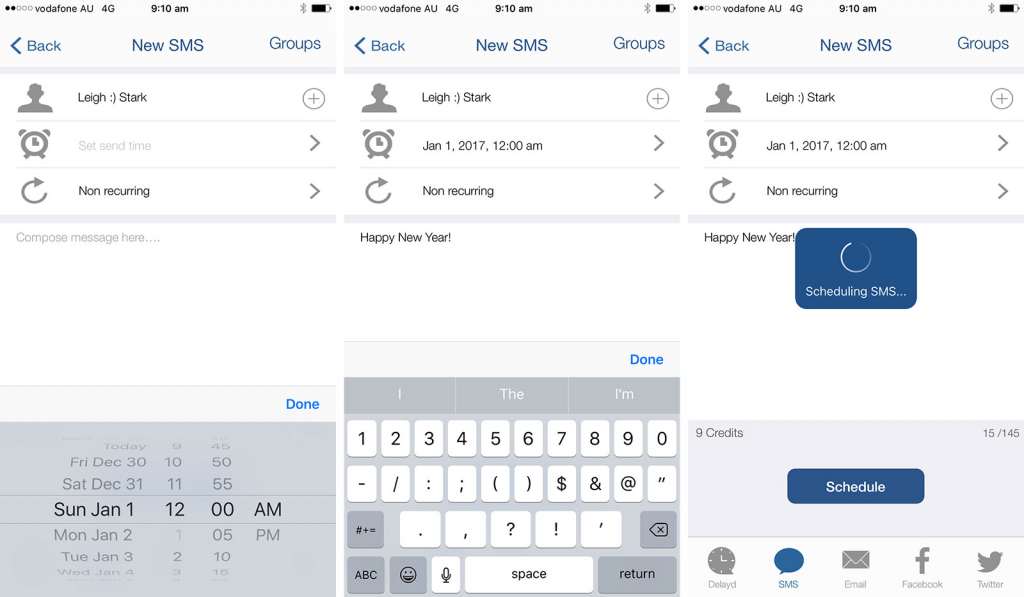It’s the end of the year as we know it, but how do you tell the rest of the world when you just know your mobile network will struggle to let you send an update?
It’s the end of the year as we know it, and you feel fine, and keen to tell the rest of the world.
That doesn’t always go to plan, so how do you get the message out when everyone else is trying to do the same and your telco is struggling under the load?
Schedule those texts
Getting messages out almost always starts with text messaging, the defacto way many of us have grown up with new year notifications, as we send out the message to friends and family.
This year as the countdown ticks down to screams of “happy new year”, you may feel inclined to send a message to anyone and everyone you feel connected with, provided it’s under 160 characters. That number is more than enough to say the standard greeting, or even something a little more witty, such as “From all of us here at Your Best Friend Ltd, Happy New Year and don’t get too drunk!” which itself if 84 characters.
With your message thought out, a good way to do this is to rely on scheduling, because you’ll be too busy enjoying the celebrations to remember to send a massive message send out.
Fortunately, SMS scheduling is a good possibility, with apps allowing you to do just that on the popular mobile platforms of Android and iOS (iPhone).
On Android, the best we’ve found is “SMS Scheduler”, a handy little app that lets you to set up messages in advance and then uses your Android’s message sending capability to send them when the moment has hit.
SMS Scheduler does come with an ad or two that sits above the keyboard limiting screen real estate, though it can be removed for two bucks. Mind you, if you can live with an ad for the one New Year’s message and then decide to get rid of the app post NYE, say on New Year’s Day, we wouldn’t blame you, though using an SMS scheduler could just change the way you talk to people, especially if you’re trying to, stagger, your conversations.
Over on the iPhone, things aren’t as peachy, with a lot of fake apps and/or apps that don’t do a whole lot of anything. If anything, the search for an SMS scheduler on iPhone is more murky because of how Apple moves to secure the iPhone, but the downside of this appears to come from the lack of checks made on the apps found on the App Store, with numerous apps that detail SMS scheduling doing anything but, and really just acting as a way of showing you ads.
After spending time with a few of these, the best we’ve found is “Delayd”, a scheduling app that works on the iPhone for more than just texts, but requires you to buy credits if you want to send texts. You get ten (10) to start with, so that might be enough to start you off if you’re only planning on sending messages to up to ten friends, but if you want more people to get your message, you need to spend something on an in-app purchase.
Delayd works differently from the Android SMS Scheduler by being the middle-man and acting as a go-between, so your message will be sent by a different number — an international one, no less — but it will still carry your name.
Armed with either of the scheduling options, you really just need to select the time you think would be best for the send out. We’re not sure that necessarily means 12.01 on January 1 given the possibility that the networks could be jammed up from everyone else sitting on the send button ready to do the same, so our recommendation is to embrace things a little earlier.
Consider sending at a few minutes before, or even smack dab on 11.59, that way you strong-arm your way to to the top of the list, getting those messages out ASAP before the network becomes flooded with other people trying to do the same.
It’s a little sad that this year none of the Aussie telcos are offering free texts sent by their own systems as has been the case in at least one prior year, as that would have made all of this so much easier.
Still, with SMS scheduling, you can at least ensure you’re good to go without needing to consult the Aussie networks. Here’s hoping they stay up and are prepared for the massive amount of phone traffic heading their way.

Enhanced bandwidth for Vodafolks
Those of you using the Vodafone network may not have to go with a delayed option, though you may want a backup plan with one of the previous ideas just in case.
According to Vodafone’s Head of Network Performance Yago Lopez, the telco has brought out the COWS to help alleviate any bandwidth concerns you may normally have, with these Cell-On-Wheels hotspots (get it?) essentially providing the Vodafone network with a boost in areas expected to get a larger amount of people.
That’s the problem with big events: they draw big crowds, and the bigger the crowd is, the harder it is for a network to deal with. If you’ve ever attended a massive concert or sporting event and tried to share pictures from your phone, you’ve probably dealt with a network that struggled under the stress of being pinged every which way, and that’s exactly what Vodafone’s portable network boosters are attempting to solve.
As for the other majors, we’re not sure if either Telstra or Optus is doing the same thing, but it wouldn’t surprise us. Neither have said anything to the media on the matter, not publicly anyway, but if you still have reception, it could be another of these cellular systems that has been setup for areas like where you expect to find yourself.
Consider Telstra Air
If you find your network access is struggling and you’re a Telstra customer, you may want to approach things from a slightly different angle: wireless networking.
Telstra’s nationwide free wireless broadband service “Telstra Air” is still up and still free for all Telstra customers regardless of if you’re using home broadband or mobile, and whether you’re prepaid or post.
The service isn’t just a free Telstra mobile service, either, leveraging broadband from both Telstra and its customers, and joining that in one giant network that you can connect to when you’re out and about.
It’s not as fast as the 4GX service Telstra presently operates across the country, feeling more like a free hotel wireless network that just so happens to extend beyond your holiday stay, offering speeds like ADSL2+ when in reach.
But while it’s not necessarily fast, it does at least offer a connection to the web that may not be as inundated as the 4G mobile network everyone else will be using, and while that won’t help with the sending of SMS, you may have better luck getting out data-driven declarations using Telstra Air if the telco’s mobile network struggles at the stroke of midnight.
A little late, but no worries
Embodying the Australian attitude of “no worries”, consider sending your messages when the network traffic needs have died down a little, as people look past their phones and celebrate the start of the new year with a smile and a drink, as opposed to merely sitting on their phone and watching as their feed changes.
There’s nothing wrong with sending the message a little later, and chances are people won’t respond immediately either, still giving your top-of-the-year messages that level of impetus you wanted them to have to begin with.
Seriously, send it at 1AM, 2AM, or when you wake up at 6 or 7AM. It’s the new year, and people will just be keen to hear from you. Happy New Year.










